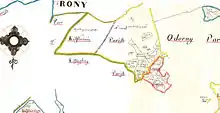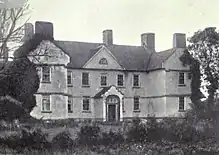
Henry Ponsonby (1620 - 1681) was a soldier in Oliver Cromwell's army during the Irish Confederate Wars who became a significant landowner and landlord when he was granted the estates of long-established settlers in County Kerry, notably the Stack family after whom Stack's Mountains are named. His family influenced Kerry politics for the next two centuries.
He was born to Dorothy (née Sands) and Henry Ponsonby at Haile Hall, near Whitehaven, Cumbria. He was part of Cromwell's army which invaded Ireland at Dublin in August 1649; his older brother, John, began the campaign as a major and had already been in Ireland a few years. Cromwell's aim was to defeat the alliance of the Catholic Confederacy and English Royalists, the latter having lost to Parliamentarians in Great Britain. The Confederate-Royalist alliance was finally beaten by 1653, but Cromwell's Act of Settlement of Ireland was drawn up the previous year. A national survey, the Down Survey, was carried out by William Petty to facilitate this. Owners of Irish land were dispossessed to varying degrees, some as punishment but in any case to pay the British troops - who had not been paid for 18 months - in lieu of wages. The Stacks, a Catholic family of Norman heritage in Kerry, had supported the Confederacy so all of their land was confiscated. Around Kilflynn and Crotta (which had been known as 'Stackstown') were the townlands owned by James Stack (Garrynagore, Gortclohy and Cloghanaleskirt), John Stack (Aghacoora), Richard Stack (Killaspicktarvin (and eight more northerly townlands)) and Thomas Stack (Gortaneare, Ballyconnell, Castletown, Crotta (also formerly known as 'Crotto'), Glanballyma, Knocknahila, Cloonnafinneela, and Cappagh).[1][2][3][4][5][6]

Following the Stuart Restoration, Ponsonby received a pardon from Charles II for all treasons, rebellions, levying of war etc., committed before and until December 29, 1660. Further changes to the Acts of Settlement were made but the townlands around Kilflynn formerly the property of the Stacks were newly confirmed as the property of Henry Ponsonby by 1666, along with Knocknaglough (240 acres) to the west, taken from another Catholic, Robert FitzMaurice (spelt 'FitzMorris' on the Down Survey); these townlands totalled at least 2000 acres in all.[3][4][7]

Ponsonby made the townland of Crotta the site for his home seat and built Crotta House there in 1669 in what was regarded as an Elizabethan style. He married Rose Weldon of St. John's Bower near Athy, County Kildare, daughter of Mary Newman and Thomas Weldon whose ancient family had a history of local representation in Kildare and English parliamentary and royal service going back to Henry VII.[1]: 2054 [8][9][10] They had seven sons and eleven daughters; ten reached maturity, namely John, Thomas, Henry, Dorothy, Mary, Jane, Honora, Anne, Eleanor and Sarah. Ponsonby's property was organised both as farmland and wood plantations. He died at Crotta in 1681, aged 61 years survived by his wife; his son Thomas inherited his property. Post mortem, he, along with Thomas Ponsonby, was attainted by the English Parliament and his name published in publicly-available lists in England and Ireland. With this, and notwithstanding family links, in the next few years claims were made by (Chidley Coote, Thomas Coote and Thomas Crosbie) that Ponsonby had been let land owned by Coote on Stack's Mountain two decades previously and failed to pay agreed rent. After several court appearances, a ruling was issued in favour of the Ponsonbys which was challenged but the case was eventually settled out of court, after which the family became very influential in Irish national affairs. Ponsonby is remembered as a poor landlord in local Irish folklore.[11][3][7][12][13][14][15]
References
- 1 2 Burke, Bernard (1909). A genealogical and heraldic history of the peerage and baronetage, the Privy Council, knightage and companionage. London: Harrison & Sons. p. 244.
- ↑ Robinson, John Martin (10 November 2019). "The remarkable restoration and revival of Haile Hall, home to one of the great dynasties of Imperial Britain". Country Life.
- 1 2 3 "The Ponsonbys". The Spectator Archive. The Spectator. Retrieved 14 February 2023.
- 1 2 "1670 Landowner Search". The Down Survey of Ireland. Retrieved 14 February 2023.
- ↑ O'Donovan, Catherine. "The Cromwellian Settlement". Clare County Library. Retrieved 14 February 2023.
- ↑ Murphy, Elaine. "Ponsonby, Sir John". Dictionary of Irish Biography. Retrieved 23 February 2023.
- 1 2 Lodge, John (1789). The Peerage of Ireland. Dublin: James Moore. p. 269-273. Retrieved 14 February 2023.
- ↑ Cockayne, George, ed. (1983). The Complete Baronetage. Vol. 4. p. 218.
- ↑ "The White Castle of Athy, and its Sculptured Stones". Journal of the County Kildare Archaeological Society and Surrounding Districts. Dublin. 4: 55. July 1905.
- ↑ "Index to the Journals of Kildare Archaeological Society". Kildare Heritage. Retrieved 24 February 2023.
- ↑ "1669 - Crotta House, Kilflynn, Co.Kerry". Archiseek. 6 June 2013. Retrieved 13 February 2023.
- ↑ Rowan, Miss A.M. (1898). "Ardfert and Aghadoe Diocese". Kerry Evening Post.
- ↑ King, William (1713). The State of the Protestants of Ireland under the late King James's Government. Dublin. Retrieved 18 February 2023.
- ↑ "Old records of Kerry". Tralee Chronicle and Killarney Echo. 13 December 1870. p. 4.
- ↑ "The Landlord". Dúchas. Retrieved 21 February 2023.